Category: Hunting Blog
Lessons from a Mature Buck
Monday of this week, Jessica Brooks of Barnes bullets harvested one of the hit list bucks, Large Left 10, at The Proving Grounds.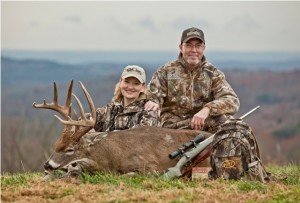 Jessica made a great shot (85 yards at 30 degrees downhill) and the Barnes VOR-TX bullet literally dropped the deer faster than my eyes could follow. She shot Left Brow Taller 10 at 1:30 PM. It was a thrilling hunt that included several lessons.
Jessica made a great shot (85 yards at 30 degrees downhill) and the Barnes VOR-TX bullet literally dropped the deer faster than my eyes could follow. She shot Left Brow Taller 10 at 1:30 PM. It was a thrilling hunt that included several lessons.
I had a lot of history with the buck that Jessica killed. He had the typical race horse appearance as a three year old. He appeared very muscular and spent a lot of time cruising. It seemed he was aggressive. We were blessed to find both of his sheds from last year and they scored 146”. They were the product of a great growing season (the right amount of rain when it was needed).
As a four year old his body had filled out more. His body was larger, but not as toned in appearance (like most men change from 30 to 40 years of age). His rack was larger also, especially noticeable in more mass! His gross score was 153. That’s about a 4.8% increase. However, that increase occurred during a year with a horrible drought during the growing season. There was no rain for 15 weeks at The Proving Grounds this summer! Any increase from 2009 to 2010 is huge! Certainly it could have been more, but most deer managers must work with what the environmental conditions are.

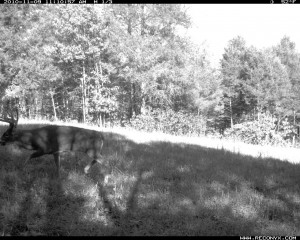
I had more than 30 Reconyx images of Large Left 10 since September 15th. However, most of them occurred once the rutting action began. In fact, during three weeks since September 15th I didn’t capture a single image of Large Left 10. My Reconyx units captured more images of Large Left 10 than any other of our 20 hit list bucks. His personality was to move, and movers are easier to harvest. Individual bucks have individual personalities. Large Left was aggressive and aggressive deer can be harvested.
Large Left 10 provided me with much enjoyment and several lessons including:
- Most bucks continue to increase in antler size until old age – older than they usually live in wild. If you wish to harvest bucks with larger antlers, you must pass younger bucks.
- Some bucks’ personality is to travel more than others and movers are relatively easy to harvest.
- During the rut, locations between feeding and bedding areas that allow a M.D.E. (Minimal Disturbance Entry) are prime locations. Jessica’s stand was on the edge of a power line that bisects a sanctuary with a feeding area (large food plot with standing Eagle Seed beans) to the east and a bedding area created by cutting trees and prescribed fire to the west. We were able to park on the ridge, walk down 100 yards and have a 400 yard view to the valley. We approached the stand about 9:00 AM and the wind currents were predominately rising so our scent was being carried up hill. The wind was swirling some, but because of the warming air during the morning, when the wind swirled the other way, the leaves were still rising.
- Patience and readiness are critical when hunting mature bucks. Jessica and I observed a shooter buck at 300 yards – twice – earlier that day. However, the shot opportunity was not ideal. Jessica is a wise and experienced hunter and opted to pass on those opportunities. She’s practiced and capable to shoot accurately at 300 yards, but the buck was in tall grass and moving. Passing those opportunities yielded a great opportunity at 85 yards on a fabulous buck.
This was a great experience in the benefits of good herd and habitat management and good hunting skills. We knew this buck was in the area, that the stand location was ideal for the rut, and remaining on the stand through the midday had a great chance of yielding an opportunity to harvest a mature buck. Jessica had the discipline to pass on marginal opportunities and the skills and gear to capitalize on a great opportunity!
With discipline you can have the same opportunities at your Proving Grounds.
Growing Deer together,
Grant
Sighting in my Rifle
I was raised in a shooting family. My Dad was the state champion of many states with a muzzleloader. Both my sisters also won several shooting matches and/or state championships. We competed in the National Muzzleloader Rifle Associations matches. Later I was a member of the rifle team for the university I attended as an undergraduate student. Shooting accurately has always been a part of my life. We built our own muzzleloaders as modern muzzleloaders were simply not available then (dating myself).
When I began “collecting” deer for pay (yes, I’ve had a great career!), Dr. David Guynn at Clemson introduced me to rolling my own (building my own bullets) to get increased accuracy. I’ve rolled my own for 20+ years.
However, I haven’t upgraded my reloading equipment in years. In addition, I’m reached a point in my life where I’d rather be with my kiddos or managing a deer herd than studying reloading guides and trimming brass. I’ve trusted Barnes for years as the bullets my daughters use to shoot deer. I want my daughters to be successful and I know Barnes bullets have exceptional accuracy and killing ability. That’s as strong of an endorsement as I can give any bullet!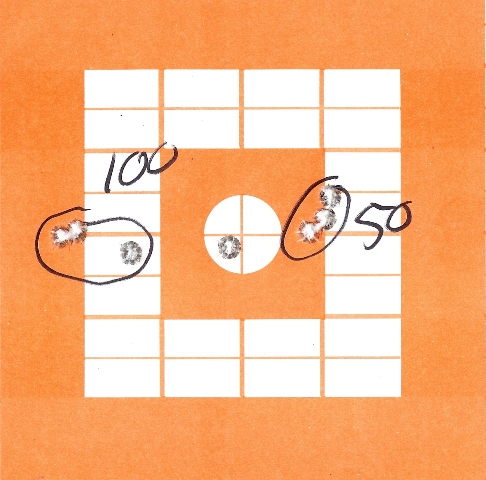
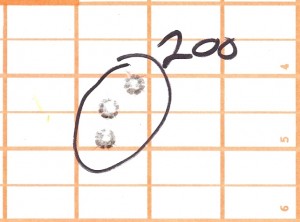
That’s why I was extremely excited when Barnes introduced the VOR-TX bullet this year. I can now have the exceptional performance of a Barnes bullet from a factory load!! This saves me time and money! I sighted in a .308 yesterday after installing a new Nikon Monarch scope. I had the gunsmith bore sight the rifle. I shot the first three at 50 yards. Shot two and shot three cut the same hole (the first shot from a clean barrel usually flies slightly different).
I then moved to 100 yards and shot a three-shot group again. Groups are what matter to me. I can easily adjust where the groups are located. I then moved to 200 yards and the Barnes delivered another three-shot one inch group! The accuracy and terminal performance of the Barnes VOR-TX bullets are simply outstanding. I’m 100% confident in Barnes VOR-TX bullets.
Growing Deer together,
Grant
The Importance of Food
Have you ever noticed how important food is to all critters? Bass fishermen concentrate their efforts on identifying what bass are feeding on that day in the area they are fishing. Many trout fishermen are even more tuned into what their prey is eating. They select flies based on what insects are hatching at that moment. This technique is called matching the hatch.
Deer hunters should pay just as much attention to the current food selections as trout fishermen. There are currently beautiful wheat food plots at The Proving Grounds. They are lush! However, I don’t believe deer have consumed one blade of the wheat yet this fall. The reason is there are currently plenty of acorns. If I selected a stand overlooking wheat last week, I’d would have only seen a deer if it was traveling through the food plots (based on Reconyx trail camera images). However, I harvested one of my hit list bucks by paying attention to what deer are currently consuming – acorns. Does are traveling to eat and mature bucks will be checking out the does.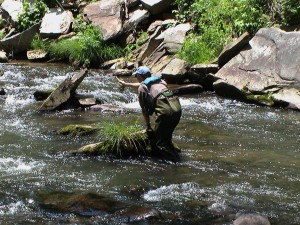
When I go trout fishing I see some insects buzzing along the water’s surface. I rarely catch my limit of mature trout. However, my buddies that are skilled trout fisherman recognize different species of insects and know which ones trout are most likely to strike. I approach deer hunting the same way. I’m most successful when I know what deer are most likely to consume and where they are finding that food source.
Just like the skilled fly fisherman that cast his fly between the overhang that is providing trout cover so they can approach the food, I wish to place my stand where deer are likely to travel while in route to the food. Knowing what food deer currently prefer and where they prefer to feed on that item is the key to hunting pre, during, and post rut. How you hunt the food source may vary (distance from cover, etc.) with the time of the year, but the knowledge required to understand the current preferred food doesn’t change.
Growing Deer together,
Grant
Grunt Call + Z7 = Success
I harvested a nice buck yesterday at The Proving Grounds. It was a thrilling hunt that included the buck grunting/balling, and then responding to my grunts by approaching my stand and actually walking a ¾ circle around me. It might have walked all the way around my stand looking for the source of the grunt he heard except the Z7 launched.
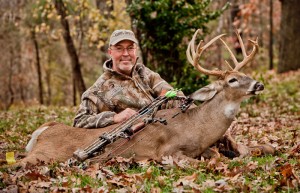 There’s much to be learned from that experience. Deer, and most wild animals, are excellent at determining the source of sound. The woods are rarely quiet as Hollywood portrays. There are small branches breaking and other common sounds that probably are not given much attention by mature bucks. Other sounds, such as metal clanking, etc., are not common and probably serve to alert deer.
There’s much to be learned from that experience. Deer, and most wild animals, are excellent at determining the source of sound. The woods are rarely quiet as Hollywood portrays. There are small branches breaking and other common sounds that probably are not given much attention by mature bucks. Other sounds, such as metal clanking, etc., are not common and probably serve to alert deer.
Bucks grunting are a normal and frequent sound in the woods this time of year, especially in areas where the deer herd has been managed to allow a substantial portion of the bucks to mature. Hence, grunt calls, as long as they are within the normal pitch and tone of real bucks’ sound, are commonly heard by deer during or just before the rut. Therefore, I use grunt calls extensively this time of year.
I prefer a call that produces a lot of volume. I will commonly look around to make sure there are no deer in view, then begin by grunting very softly. Loud grunts may alert deer that are close by and don’t expect a mature buck to be that close. If there is no response, I call again using more volume.
The second way I use a grunt call is to attempt to make deer I observe to approach closer to my stand. I simply judge how far the deer is from the stand, then call just loud enough so they can hear the call. I typically call softly and increase the volume until the buck acknowledges the call.
Don’t be scared to use a grunt call. This week throughout most of the whitetails’ range is a great time to use a grunt call. I use a homemade call that a friend gave me. It can produce a lot of volume and the tone is medium to deep. Grunt calls are one of my favorite tools to harvest mature bucks.
Growing Deer together,
Grant
The Importance of Rangefinders
Reviewing Management Practices
I like to review the success or failure of all management practices implemented on my projects. Each hunting season is a management practice that produces quantifiable results (harvests) that can be compared year to year or from property to property.
We harvested six mature gobblers and one jake (GDTV 23). We had more opportunities that did not end with a harvest for various reasons — the camera and shooter weren’t lined up together, etc. Every hunter except one saw mature toms in harvest range. Three hunters harvested their first bird. Any way you measure, it was a great turkey season at The Proving Grounds! However, other folks in our county didn’t share in our success. The Proving Grounds is split by the Stone/Taney county line. The following data indicates that that turkey population in Taney County is down.

However, the establishment of good food, cover, and predator control helped build a great turkey population. It was an oasis for wildlife and for hunters. We enjoyed a fabulous turkey season at The Proving Grounds! The good news is — you too can create your own oasis by implementing good habitat and population management programs and strategies.
Growing Deer (and turkeys) together,
Grant
Planting Before the Rain
It’s raining in western Oklahoma and has a 60% chance of rain at The Proving Grounds tomorrow so Brad is no-till drilling Eagle Seed beans today. I’m finishing some office work and will take over for Brad later this afternoon. When conditions are right, the tractor stays running till it’s too dark to see where to plant. Some recent research from Iowa State strongly indicates that getting soybeans in the ground early results in higher yields than waiting until there is no chance of a late frost. Planting crops is always a gamble and I’m going for a larger yield and gambling the air temps won’t get below 28 degrees or so after the beans germinate. Only time will tell…
Growing Deer together,
Grant
Big Turkey
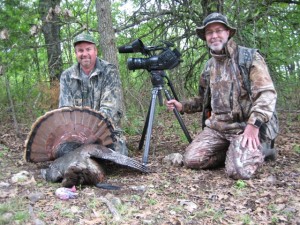 My friend, Scott Reynolds, and I went turkey hunting this morning. This is the 23rd year that we’ve turkey hunted together — no missed seasons! The morning was misty and cloudy. After we got set up we heard a bird gobbling off of the roost 400 yards away. We held our ground and about an hour later the bird made it to us. Scott was on him, but I couldn’t get a good view of the shot with the camera because of our position in the ground blind. The gobbler walked off twice while we waited for a good shot, for Scott and the camera. The third time was a charm and Scott had a 2 year old turkey: 20.6 lbs, 9 ½’ beard, 13/16” spurs. This is a big 2 year old for the Ozarks. Once again, another indicator that the habitat work here pays off at hunting time! Tomorrow it is my turn. Scott will be filming and I’ll be taking a new Matthews Z7 out.
My friend, Scott Reynolds, and I went turkey hunting this morning. This is the 23rd year that we’ve turkey hunted together — no missed seasons! The morning was misty and cloudy. After we got set up we heard a bird gobbling off of the roost 400 yards away. We held our ground and about an hour later the bird made it to us. Scott was on him, but I couldn’t get a good view of the shot with the camera because of our position in the ground blind. The gobbler walked off twice while we waited for a good shot, for Scott and the camera. The third time was a charm and Scott had a 2 year old turkey: 20.6 lbs, 9 ½’ beard, 13/16” spurs. This is a big 2 year old for the Ozarks. Once again, another indicator that the habitat work here pays off at hunting time! Tomorrow it is my turn. Scott will be filming and I’ll be taking a new Matthews Z7 out.
Growing Deer (and turkeys) together,
Grant
More Gobbler Action
Like myself, Brad believes in sharing his love of hunting with today’s youth. Brad made time to take Justin out on a youth hunt last weekend. Justin’s jake was 15 lbs.
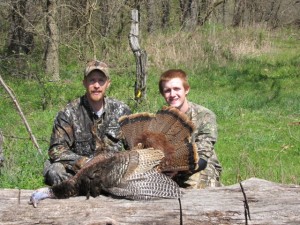
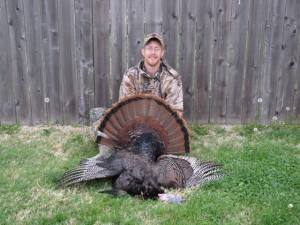
An avid hunter, Brad never has trouble waking up early to get out. Yesterday his dedication paid off. Brad headed out early in the morning and waited quietly until he heard gobbles over in the distance. He was able to enjoy success with a 21 lb, 10 1/4” beard, 9/16” spurs gobbler.
Growing Deer together,
Grant
Another Gobbler!
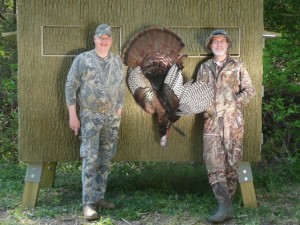 This morning I headed out early to go turkey hunting with my brother-in-law, Darrell Avery. The morning started slow and quiet, the birds didn’t gobble off the roost. About an hour after sunrise we started to hear a few gobbles in the distance. Being a cut and run turkey hunter normally I would’ve headed off towards the gobbles. But having a camera in tow, we had incentive to wait it out. A hen pitched directly in front of our blind, ignored the decoy and fed all the way out of the food plot. Awhile later, after a bit more aggressive calling, a mature bird walked directly to the jake decoy – silently. I was filming away and could tell that Darrell was eager to fire. So I gave a single yelp and the gobbler stuck his head up and Darrell made the shot. After a few high fives we saw two more toms run in. This is something I’ve got to learn about blinds versus cut and run hunting – blinds can limit your peripheral vision. I could have made the shot at the 2nd adult tom, but I saved it for another episode of GrowingDeer.tv.
This morning I headed out early to go turkey hunting with my brother-in-law, Darrell Avery. The morning started slow and quiet, the birds didn’t gobble off the roost. About an hour after sunrise we started to hear a few gobbles in the distance. Being a cut and run turkey hunter normally I would’ve headed off towards the gobbles. But having a camera in tow, we had incentive to wait it out. A hen pitched directly in front of our blind, ignored the decoy and fed all the way out of the food plot. Awhile later, after a bit more aggressive calling, a mature bird walked directly to the jake decoy – silently. I was filming away and could tell that Darrell was eager to fire. So I gave a single yelp and the gobbler stuck his head up and Darrell made the shot. After a few high fives we saw two more toms run in. This is something I’ve got to learn about blinds versus cut and run hunting – blinds can limit your peripheral vision. I could have made the shot at the 2nd adult tom, but I saved it for another episode of GrowingDeer.tv.
Growing Deer together,
Grant



